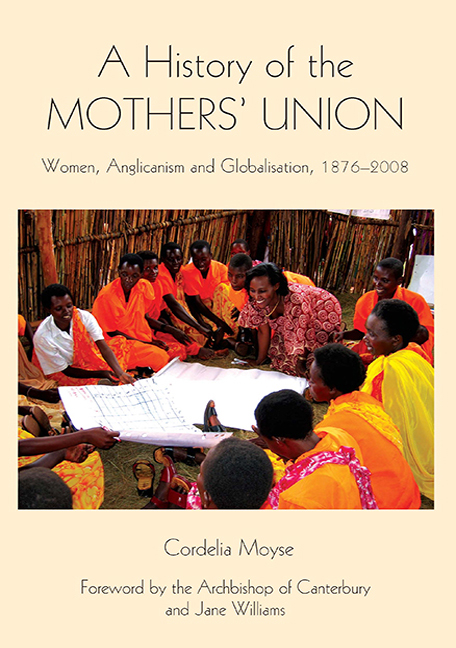Book contents
- Frontmatter
- Contents
- Dedication
- List of Illustrations
- Foreword by the Archbishop of Canterbury and Jane Williams
- Acknowledgements
- Abbreviations
- Introduction
- Part I 1876–1909
- Part II 1910–1944
- 5 Identity and Spirituality
- 6 Marriage and Family Life
- 7 Membership and Worldwide Work
- Part III 1945–1974
- Part IV 1975–2008
- Conclusion
- Appendix 1 Text of early membership cards
- Appendix 2 Development of the Mothers' Union prayer
- Appendix 3 Midday prayers (original)
- Appendix 4 Development of the objects
- Appendix 5 Biographical notes on central and worldwide presidents
- Bibliography
- Index
- Miscellaneous Endmatter
5 - Identity and Spirituality
from Part II - 1910–1944
Published online by Cambridge University Press: 29 April 2017
- Frontmatter
- Contents
- Dedication
- List of Illustrations
- Foreword by the Archbishop of Canterbury and Jane Williams
- Acknowledgements
- Abbreviations
- Introduction
- Part I 1876–1909
- Part II 1910–1944
- 5 Identity and Spirituality
- 6 Marriage and Family Life
- 7 Membership and Worldwide Work
- Part III 1945–1974
- Part IV 1975–2008
- Conclusion
- Appendix 1 Text of early membership cards
- Appendix 2 Development of the Mothers' Union prayer
- Appendix 3 Midday prayers (original)
- Appendix 4 Development of the objects
- Appendix 5 Biographical notes on central and worldwide presidents
- Bibliography
- Index
- Miscellaneous Endmatter
Summary
Prior to 1912 the MU's spirituality was largely that of a movement rather than an institution. While a common prayer life and mission were articulated in publications, there was little evidence that the MU was a coherent group of devout Christian women. It was only in the years after 1910 that the MU became a recognisable Anglican institution. Previously this was an implied identity but not one fully worked out or widely understood and accepted within the organisation. The intensity of the debates on the MU's identity throughout the period and the resulting outcomes reveal that the MU was far from being a homogeneous body and undermine accusations that it was quite the authoritarian organisation its later detractors would claim.
The MU's ability to develop in this period owed as much to reaffirming what was argued to be its original identity as to renewing itself in the light of contemporary needs. The Great War was an important spur to innovation and adaptation as it provided a judgement on the past performance of the MU in ‘winning homes for Christ’ as well as new opportunities for the expression of Christian spirituality. Members were brought together in new forms of corporate spiritual activity, the most significant being their participation in calls for spiritual renewal and their building of a chapel at Mary Sumner House. Change was also embraced to serve organisational goals. New prayers, new occasions for prayer and their own chapel bound members more closely to the MU's central purpose as a community of prayer. This period saw the emergence of the MU icon of the Blessed Virgin Mary: the Sistine Madonna by Raphael. It appeared on badges, banners and membership cards. This potentially dangerous image of Mary (and her High Church associations with Roman Catholic veneration of the saints) was carefully cropped: its other-worldly setting was minimised and the saints and papal tiara were removed so as to avoid any sense of her as a divine mediatrix between Jesus and humanity. While the MU took up this image at the high point of the Anglo-Catholic movement within the Church of England, its theology of Mary was mainstream Anglican, most clearly articulated in its celebration of the Feast of the Annunciation. At the same time it promoted and revitalised another ancient church occasion for celebrating Mother Church and human mothers, Mothering Sunday, which was thought to be under threat from commercialism.
- Type
- Chapter
- Information
- A History of the Mothers' UnionWomen, Anglicanism and Globalisation, 1876–2008, pp. 97 - 115Publisher: Boydell & BrewerPrint publication year: 2009



